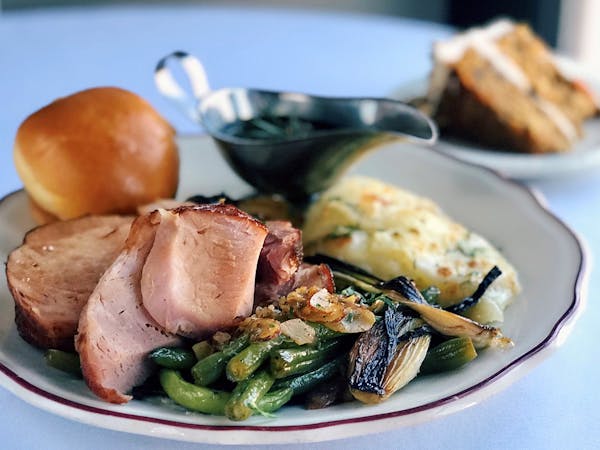After a week of straight screen time — meetings on Zoom, Skype, FaceTime with family and friends — we all deserve a nice lunch. Take a break, stretch, get a breath of fresh air, move around. Stop.
It's tempting to graze on chips and cookies through the day, instead of making the time to eat in place. But make that time.
Lunch used to be the time to meet a friend or run an errand. Now it's an opportunity to rethink our weekly menus. With a little planning, we can pivot to create simple, healthful meals that nourish and delight.
Pick a day to prepare a week's menu ahead. Think about dinners that provide the makings for sandwiches, salads and soups, and breakfast dishes. Get everyone in the house involved so they have the makings for their own lunches and snacks.
Make big batches of basic foods to keep for a week in a covered container in the refrigerator:
• Whole grains like barley, wheat berries, whole oats and quinoa are great for pilafs, soups, stews, salads and breakfast bowls.
• Cooked dried beans are great in salads, soups, stews, hummus and dips.
• Roasted root vegetables include carrots, potatoes, turnips, beets and turnips, all wonderful tossed with pasta, grains and into salads.
• Mashed potatoes and sweet potatoes make a great base for fried eggs, to stir into cream soups and for potato cakes (see recipe).
• Hard-cooked eggs are great for salads and to layer on sandwiches and garnish soups and pilafs.
Working from home, with kids, barking dogs, a spouse and/or roommates around is stressful enough. A good lunch will lift your spirits as well as your energy.
Thank goodness that farmers markets are considered "an essential service," according to Minnesota guidelines, and will continue to provide fresh produce, meat, eggs, honey and maple syrup, though with a limited schedule (see contact info at right). They remind us that spring is on its way and the growing season is coming soon. It's a good time to sign up for a share in community-supported agriculture (CSA) now, too, as well as to plant seeds, order starter vegetables and watch our gardens bloom.
Beth Dooley is the author of "In Winter's Kitchen." Find her at bethdooleyskitchen.com.
Loaded Mashed Potato Cakes
Makes 4 to 6 cakes.
Note: Crisp and savory, these are a sophisticated version of the beloved Tater Tots and ideal carriers for cooked vegetables, chopped bacon or whatever leftovers you might have on hand. Serve with yogurt sauce on the side. From Beth Dooley.
• 3 c. mashed potatoes (see directions below)
• 2 garlic cloves, minced
• 1/2 c. fine cornmeal, divided
• 2 tbsp. finely chopped fresh parsley
• 1 egg
• Sunflower or vegetable oil for frying
Directions
In a medium bowl, stir together the potatoes, garlic, 3 tablespoons cornmeal, parsley and egg.
Heat the oven to 350 degrees. Form the potato mixture into rounds about 3/4-inch thick. Put the remaining cornmeal into a shallow dish.
Working in batches, heat 2 tablespoons oil in a large skillet over medium heat. Coat the potato cakes on each side in cornmeal, brown lightly on both sides in the skillet and transfer to a baking sheet. Repeat with the remaining potato cakes, adding more oil as needed between batches. Bake the cakes until heated through, about 5 to 8 minutes. Serve with cooked fresh or frozen peas and pea shoots for garnish.
To make mashed potatoes: Use 1 to 1 1/2 pounds peeled russet potatoes. Put in a pot with enough water to cover the potatoes by an inch. Add a generous pinch of salt. Set over high heat, bring to a boil, reduce the heat and simmer until the potatoes are very tender. Drain off any excess water. Mash the potatoes, adding warm milk or cream, and season with salt and pepper.
To make the yogurt sauce: Stir together 1 cup whole-milk Greek yogurt with 2 to 3 tablespoons chopped parsley and 1 teaspoon fresh lemon juice.
Nutrition information per each of 6 servings:
Calories200
Fat6 g
Sodium150 mg
Carbohydrates33 g
Saturated fat1 g
Added sugars0 g
Protein4 g
Cholesterol32 mg
Dietary fiber3 g
Exchanges per serving: 2 starch, 1 fat.

Summer Movie Guide: Virtually all the movies coming to theaters and streaming from May to Labor Day

